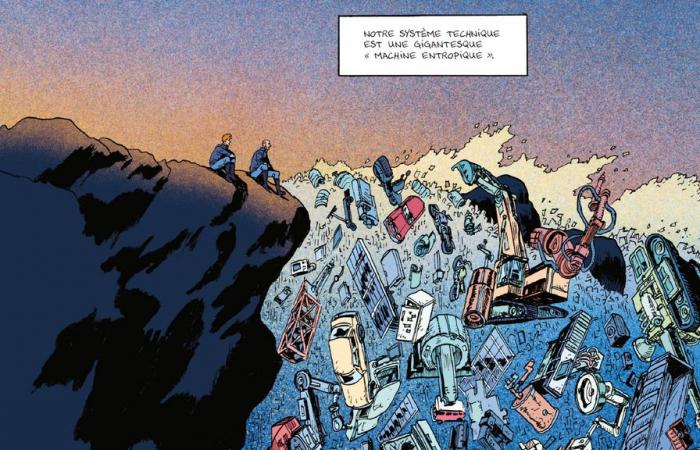Calcite, kaolinite, talc, titanium dioxide… In the presentation he published on Linkedin on the occasion of the release of his first comic book – Resources, a challenge for humanity (ed. Casterman) – Philippe Bihouix cannot help but briefly list all the minerals which were used to produce the pages. Throughout the work, the central engineer specializing in metals will regularly do the same. An educational bias, in order to make his interlocutor – who is none other than the designer of the work, Vincent Perriot, who stages himself in a long discussion punctuated with humor and intellectual references – aware of the material weight of our daily lives and the limits it poses.
An (increasingly) material world
Obviously inspired by documentary comics The Endless World – a best-selling book co-written by Jean-Marc Jancovici and Christophe Blain on the theme of energy – the authors focus in their book on the equally crucial and distressing question of resources. Virtually traveling through mines and factories around the world, they make good use of comics to show the crazy growth in metal extraction that has never stopped since the industrial revolution.
Far from being just a simple object lesson, which teaches the reader that a state-of-the-art telephone contains 45 different metals or that there are rare earths in lighter flints, the comic strip defends a thesis which does not will not surprise readers of Philippe Bihouix. There is in reality no dematerialization, as the proliferation of data centers and submarine cables behind digital technology reminds us. However, the exponential growth in material consumption is unsustainable in the face of the finiteness of resources, and the increase in energy requirements for activity caused by the downward trend in the contents or accessibility of deposits.
No salvation in space
If the solutions proposed can sometimes seem summary or shaky, the work (whose bibliography and appendices on the use of resources and the production of waste in the world are appreciated) has the merit of raising central questions, often overlooked. silence. Placing himself in an old debate personified by different intellectual figures, he introduces us to a number of intellectuals who have warned (like the Club of Rome) about the finiteness of resources. But also their adversaries, the “cornucopians”, who are convinced that innovation and technology will always make it possible to find solutions to move towards a world of abundance.
It is on this subject that the authors are the most original – and benefit from the science fiction drawing experience of Vincent Perriot – by returning to one of the last bets of this camp (which has for the moment still succeeded in shifting the peak of resources): that of the conquest of space. This is the path that would allow, as Jeff Bezos explains at the Washington Convention Center 2019 in the scene that opens the comic strip, to escape from the finiteness of earth’s resources.
A technological and political aberration, judges Philippe Bihouix, who calls for a “technically sustainable” civilization, built on sobriety, the economy of rare resources and recycling. Before recalling that this last route is necessary, but does not allow all of the materials to be recovered, because they disperse in the environment during use or are diluted in alloys. A reading that makes you rethink the objects purchased and produced in the light of data and often distressing notions… Which can sometimes inspire manufacturers, like the concept of “metals of hope” forged by the Dutch researcher Andre Diederen to designate the most abundant metals in the earth’s crust, such as silicon, magnesium and aluminum.
Selected for you






